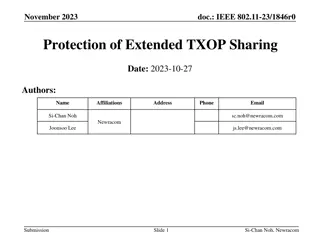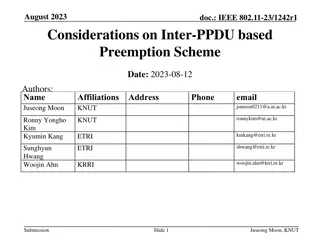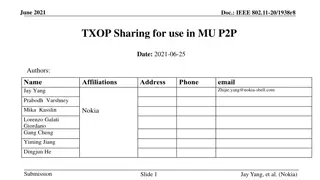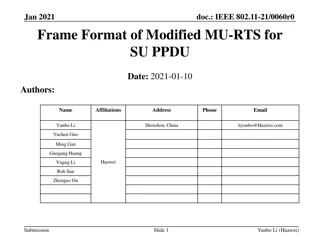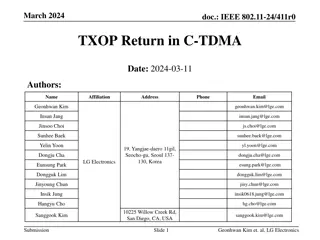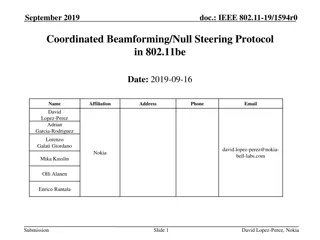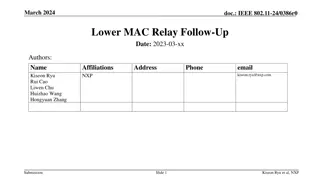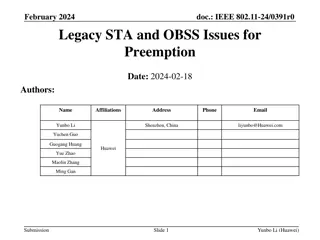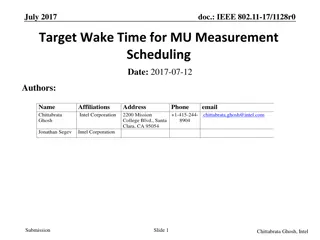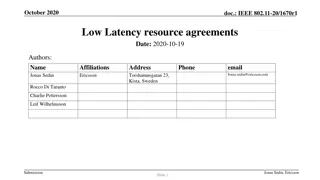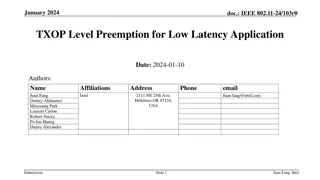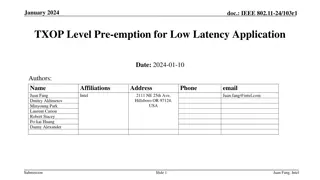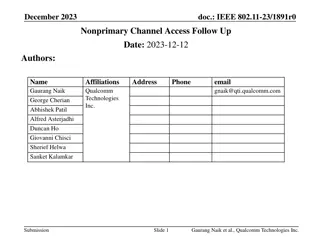IEEE 802.11-23/1874r0: Reverse TXOP Sharing for Improved Wireless Communication
This contribution presents the concept of Reverse TXOP Sharing in IEEE 802.11 networks, allowing non-AP STAs to share their TXOP with APs for efficient data transmission. The proposal addresses current limitations in TXOP utilization and offers a mechanism for enhanced Downlink and Uplink traffic ma
4 views • 11 slides
Protection of Extended TXOP Sharing in IEEE 802.11-23/1846r0
Reusing EHT's Triggered TXOP Sharing framework for extended TXOP sharing is discussed in this document, focusing on enabling sharing APs to distribute their obtained TXOP among other BSS(s). The document explores issues related to TXOP sharing for UHR STAs when a sharing AP allocates a portion of it
0 views • 12 slides
Considerations on Inter-PPDU Based Preemption Scheme in IEEE 802.11-23
In this document, considerations are presented for a preemption scheme in IEEE 802.11-23, focusing on issues such as coordination, ACK transmission timing, and channel access fairness. The proposed inter-PPDU based preemption scheme aims to improve the transmission of low latency traffics within the
1 views • 12 slides
IEEE 802.11-20/1938r8 TXOP Sharing for MU P2P Communication
The document discusses the IEEE 802.11-20/1938r8 standard and proposes mechanisms for an Access Point (AP) to facilitate peer-to-peer communication between stations (STAs). It introduces the concept of triggered TXOP sharing to enhance latency performance and spectral efficiency in scenarios involvi
8 views • 8 slides
Coordinated AP Time/Frequency Sharing in IEEE 802.11be
The document discusses the concept of Coordinated AP (CAP) Time/Frequency Sharing within a Transmit Opportunity (TXOP) in the IEEE 802.11be standard. It explains the procedures of Frequency and Time resource sharing, highlighting the benefits such as latency improvement and throughput fairness. Deta
0 views • 16 slides
IEEE 802.11-21/0060r0 Jan. 2021 Modified MU-RTS Frame Format
This document discusses the frame format and structure of a modified MU-RTS (Request to Send) used in IEEE 802.11 standards for transmitting non-TB (Trigger-Based) PPDUs. The modified MU-RTS allows an Access Point (AP) to allocate time for a target Station (STA) to transmit Single User (SU) PPDUs wi
0 views • 10 slides
Enhancing Low Latency in IEEE 802.11 Networks
Various mechanisms for low latency in IEEE 802.11 networks are discussed, including C-TDMA, C-RTWT, TXOP Preemption, and HiP-EDCA. This proposal aims to improve initial control frame exchanges to prioritize low latency traffic transmission. By modifying exchange rules and allowing STAs to signal the
0 views • 12 slides
IEEE 802.11-24/411r0 TXOP Return in C-TDMA
This document discusses the TXOP return mechanism in C-TDMA operation for IEEE 802.11 networks. It explores the importance of timely TXOP return for efficient utilization of medium and proposes considerations for implementing TXOP return in C-TDMA. Various TXOP return scenarios and frame types are a
0 views • 11 slides
Coordinated Beamforming/Null Steering Protocol in IEEE 802.11be
Coordinated beamforming/null steering is a promising scheme in IEEE 802.11be for joint transmission/reception challenges. This protocol aims to efficiently realize gains by establishing semi-static inter-AP coordination, enhancing spatial reuse opportunities, implementing CSI acquisition, and managi
0 views • 15 slides
Enhancing Power Save Mechanisms in IEEE 802.11 for Non-AP STAs
The document discusses improving power save mechanisms for non-AP STAs in IEEE 802.11 by focusing on reducing power consumption during listen mode, enhancing flexibility in transitions between power states, and proposing solutions to enable reception on smaller bandwidths. It emphasizes the importan
0 views • 11 slides
IEEE 802.11-24/0386r0 Lower MAC Relay Protocol Details
Detailed discussion on supporting the relay protocol in IEEE 802.11bn, covering relay addressing, end-to-end BA, relay TXOP protection, beacon forwarding, security processing, non-UHR STA support, sounding procedure, A-MPDU aggregation, de-aggregation, and more. The relay operation involves relay de
0 views • 16 slides
Legacy STA and OBSS Preemption Considerations in IEEE 802.11-24
Discussions in IEEE 802.11-24 address preemption issues related to UHR STAs within a single BSS, focusing on legacy STA impact and OBSS considerations. Proposed solutions aim to balance efficiency and latency by adjusting TXOP limits for different STA types.
0 views • 7 slides
Power-Efficient Scheduling for MU Measurement in IEEE 802.11-17
In this presentation related to IEEE 802.11-17, a power-efficient scheduling mechanism is proposed for power save STAs aiming to perform 11az-based measurements. The focus is on maximizing efficiency through NDP-based sounding mechanisms, UL and DL soundings, resource allocation, polling phases, wak
0 views • 11 slides
Uniform Procedure for Preemption in IEEE 802.11-24 Standard
The presentation discusses a uniform procedure for preemption in the IEEE 802.11-24 standard, focusing on different cases where a STA preempts another's TXOP to transmit low latency (LL) traffic. It proposes a simplified design and implementation approach for handling preemptions efficiently. The pr
0 views • 12 slides
Low Latency Resource Agreements in IEEE 802.11-20 for Better Channel Access
Proposal suggests enabling agreements between nodes with different traffic requirements to share resources during reserved TXOP, ensuring more predictable channel access and lower latency for critical transmissions in IEEE 802.11-20 networks.
0 views • 16 slides
Dynamic Channel Switch Operation in IEEE 802.11-24 Standard
STAs in IEEE 802.11-24 can dynamically switch to secondary channels per the AP's request for frame exchanges. The process involves soliciting control frames, determining parking channels, managing frame exchanges, and switching back to the primary channel at the end of a TXOP. Various examples illus
1 views • 11 slides
IEEE 802.11-24/103r0 TXOP Level Preemption for Low Latency Application
This document discusses the implementation of preemption as a solution to support low latency applications in IEEE 802.11 scenarios. It focuses on dividing large PPDU into smaller ones with time gaps for preemption opportunities. The approach involves common preemption requests and triggering LL pac
0 views • 9 slides
Enhancing Low Latency Applications with Pre-emption in IEEE 802.11-24/103r1
Discussion on pre-emption as a solution for low latency applications in UL SU TXOP scenarios. Techniques for dividing large PPDU into smaller ones, allowing pre-emption opportunities, and enabling LL PPDU transmission after pre-emption are explored. Strategies for AP to initiate LL packet transmissi
0 views • 8 slides
Enhancing Spectral Efficiency Through Nonprimary Channel Access in IEEE 802.11
IEEE 802.11 is exploring nonprimary channel access to address underutilization of spectrum and improve latency and throughput. This approach involves enabling nonprimary channel access with simple modifications to existing rules, such as limiting TXOP duration and using control frames for coordinati
0 views • 13 slides

